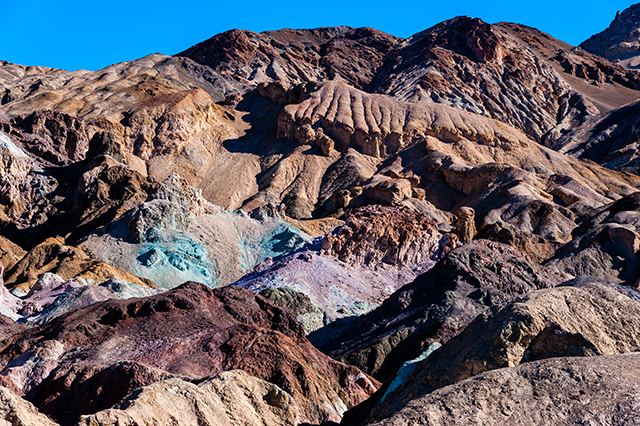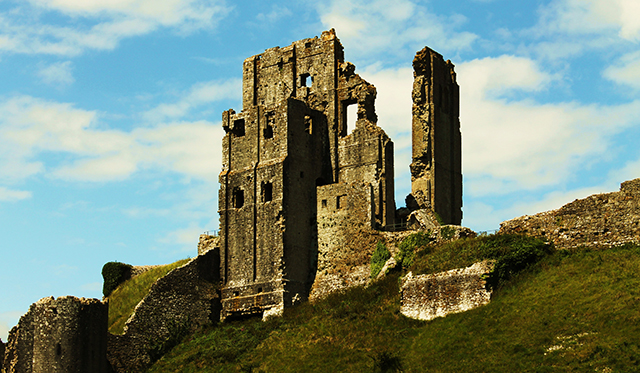Early Life in Death Valley

Paul Knauth scrambled up a steep, rocky canyon in the Black Mountains of Death Valley National Park, sporting gloves and a walking stick to help navigate the sharp scree. The desert floor shimmering below holds the record as the hottest place on Earth, but in late February, wildflowers were sprouting from tiny fissures. We stepped carefully, lest we endanger their fragile existence — or our limbs.
At last we reached our goal in this forbidding terrain: an approximately 750-million-year-old cave that Knauth, 69, a geochemist and geologist at Arizona State University, and the late Robert Horodyski, a paleontologist, had stumbled across two decades ago. The shape of the cave is stamped into a wall of dolomite; it is big enough to hold a human, but packed solid with a finely powdered quartz. The scientists discovered the cave while searching for microfossils to buttress their then-radical theory that microbial life flourished on land more than a billion years ago. Before he retires, Knauth would like to add microfossils from the cave to the body of evidence that supports his evolutionary model.
According to prevailing wisdom, the continents were lifeless, irradiated rock shelves until after the occurrence known as the Cambrian explosion in the seas 540 million years ago, when the precursors to rooting plants and animals burst forth from the ocean to colonize the land. Knauth has long led the charge to challenge that narrative, which is biased by the fossil record, he said. Marine fossils are protected by layers of marine sediment and the quietude of ocean deeps. Land fossils are much more likely to have been pulverized by changing climates and erosion long before paleontologists could have chanced upon them. The fossil record, therefore, is heavily weighted toward the seas, making it appear that they were the cradle of life.
According to Knauth, the surviving land-based fossils are most likely to be tiny and hidden in “geological time capsules,” such as the Death Valley cave, which has withstood volcanoes, glaciers and the clashing of continental plates. During the last 10,000 years, the cave was sliced open by rainwaters flushing the surrounding landscape, a 750- to 800-million-year-old geological formation called the Beck Spring Dolomite. In the early 1990s, Knauth analyzed the geochemistry of the surface of this 1,000-foot layer of dolomite. His results showed that the region seethed with mats of photosynthesizing, unicellular life forms long before the Cambrian explosion.
Even more telling are microfossils that Knauth and his colleagues have unearthed from ancient holes pocking the barren surface of the dolomite. Taken together, the geochemical and microfossil findings support his theory that during the Precambrian eon, complex life forms evolved not only in the oceans, but also on land. In fact, as Knauth has argued in a string of papers published in Science, Nature and other journals since 1985, animals may have originated in freshwater lakes, rivers and streams, and not in the super-salty, oxygen-starved oceans.
Nearly 30 years later, the field is finally catching up with him. During the last half decade, a number of researchers have reported an abundance of geochemical and microfossil evidence that life inhabited the continents as far back as 2.2 billion years ago.
“Knauth’s work has been inspirational,” said Kurt Konhauser, a professor of geomicrobiology at the University of Alberta in Edmonton, Canada, and editor of the journal Geobiology. “He opened up the door for the rest of us to pursue evidence of Precambrian life on land.”
While many paleobiologists now accept Knauth’s premise that simple, unicellular life forms existed on land during the Precambrian, others recoil from his more radical proposal that complex, multicellular life — and even animal life — also thrived on land more than 600 million years ago. Over a wilderness campfire the night before our climb to the cave, the soft-spoken Knauth confided that he enjoys challenging the prevailing paradigms in science and plans to keep it up. “In my old age, I am so disappointed that people close their minds and jump on whatever splashy, simplistic bandwagon is in vogue,” he said. “But if you start with the rocks and work upward to an interpretation, it often reveals a reality that is not the one in vogue.”
Knauth could retire from fieldwork, but curiosity keeps him scaling the hot, dry, rugged mountains in Death Valley and elsewhere in the Southwest. Exuberantly searching for more caves, he hopes to find incontrovertible fossil evidence of primitive animals that once feasted on the lush green mats of single-celled organisms that he says blanketed the continents during the Precambrian.
“A petrified bedbug would end the dispute,” he said with a grin.
Eroding a Paradigm
The Beck Spring Dolomite was born about 750 million years ago, when a 1,000-foot layer of calcium magnesium carbonate settled in a shallow marine environment at the edge of Rodinia, a super-continent that was tearing itself into pieces. The giant mass of carbonate climbed out of the sea, transforming into land under a hot and humid climate. In a geological process known as karstifying, acidic rains sculpted the carbonate rock into a maze of pits, sinkholes and caverns, including the cave we’ve trekked to on this visit.
About 60 percent of U.S. land east of the Mississippi River is in the process of karstifying, making it resemble a sort of rocky Swiss cheese. But vegetation and lakes often obscure these geological formations from our view. In the arid deserts of the Southwest, karsts are easier to spot, even though they are much older and have eroded. The canyon we traversed en route to the cave cuts through a huge slab of dolomite, a tan-to-pinkish rock that crumbles underfoot. The ancient karst pits are distinguishable from more recently eroded holes by the piles of quartz rubble that fell into them as they formed.
Knauth began exploring desert karsts in the 1980s as a young geology professor building his lab at Arizona State. He was already an expert at analyzing rocks for geochemical signs of preserved organic matter. The key is in the rock’s atomic composition; organisms that use sunlight for energy incorporate a lighter version of carbon, called carbon 12, over the heavier carbon 13. This means that regions that once harbored photosynthetic life contain slightly lower amounts of carbon 13 than sterile areas.
Much to their astonishment, Knauth and his graduate student at the time, Mark Beeunas, discovered that a 1.2-billion-year-old desert karst in central Arizona called the Mescal Limestone showed geochemical signs of life during the Precambrian eon “It was surprising because, according to all of the textbooks, the Precambrian lands were totally barren,” said Knauth, who published the geochemical findings in 1985.
While Knauth’s peers did not contest the accuracy of his results, his conclusion that life on land predated the Cambrian era by 660 million years was met with silence. “The Cambrian explosion had a paradigm lock 30 years ago,” Knauth said. “It was practically inconceivable to most paleontologists that what I had found out could even possibly be true.”
Needing more evidence to buttress his paradigm-challenging claim, Knauth went in search of signs of life in Death Valley, sampling an unusual ridge of black quartz on top of the Beck Spring Dolomite. Back in the lab, geochemical analysis revealed low levels of carbon 13; photosynthesizing organisms had lived there, lots of them, he concluded. And where there are geochemical signs of life, there could also be microfossils.
Knauth, Horodyski and Ray Kenny, a student, spent three years traversing the dangerous steeps of the Beck Spring Dolomite and the Mescal Limestone gathering rocks that they hoped contained those microfossils. They often fell asleep exhausted around a desert campfire, their clothing and boots shredded by sharp rocks.
They hauled their desert bounty back to the lab and sliced the rock samples into thin, light-permeable sections with a diamond saw. Peering through a microscope, they detected dozens of filaments and spheres, which they identified as mineralized cells. Over time, their desert wanderings produced a veritable zoo of microfossils. At 750 million to 1.2 billion years old, they were the oldest land-based fossils that had been discovered to date. Horodyski and Knauth reported their landmark discoveries in the journal Science in 1994.
“Knauth’s geochemical analysis of the paleokarsts was the pioneering research for showing the existence of life on land during the Precambrian,” said Paul Strother, a paleobiologist at Boston College.
The Amber of the Precambrian
The Beck Spring formation stretched before us, angular and dusty with few signs of life. But to Knauth’s mind, its surface was once a glistening green, covered by photosynthesizing cells, cyanobacteria and algae. These simple organisms turned sunlight into energy and oxygen, leaving behind the telltale trail of carbon 13. Rainwaters flushed through the thick wet mats of living cells on the surface, sometimes pulling individual cells into the karstifying holes, where they became trapped between pieces of rubble. Iron in the water adhered to the trapped, rotting microbiota, hardening the structure. The new fossils were gradually encased in tiny seams of crystallizing silica (quartz) that grew between the bits of rubble, cementing them together.
Knauth calls this cement the “amber of the Precambrian.”
Paradigms are hard to topple, but no one has refuted the basic scientific argument that Knauth first broached in 1985, and he has been refining it ever since. As a consequence, the commonly held assumption that the continents were barren of life until after the Cambrian explosion has been steadily eroding.
“It’s only in the last five years that this 20-year-old discovery has begun to strongly influence the field,” said Stanley Awramik, a geobiologist at the University of California, Santa Barbara. Researchers like Strother have begun to find more evidence of Precambrian land fossils.
Advances in geochemical and genetic technologies are partially responsible for the surge of interest in searching for microbial life on Precambrian lands. “People now realize that there was a world of microscopic ground huggers that did not leave behind the wealth of fossils that make it easy to find marine life,” Knauth said. And the search for traces of life in Martian deserts has heightened researchers’ interest in spotting primal Earth life forms in harsh, non-marine environments, he observed.
As far as Knauth is concerned, the simplest explanation for the fact that low levels of carbon 13, those geochemical ghosts of ancient photosynthesizers, coexist with cell-like microfossils is that there were massive amounts of life on land during the Precambrian. And his formerly outlandish theory is now widely accepted by geobiologists. “Knauth’s microfossils are tangible evidence that terrestrial life existed during the Precambrian,” said Shuhai Xiao, a geobiologist at Virginia Polytechnic Institute and State University.
Precambrian Jungles
Knauth’s evolutionary model goes far beyond debunking continental sterility. According to him, the biomasses inhabiting Death Valley and Arizona were comparable to the ones now growing in the Bahamas and the West Indies. Studies of the islands’ geology, conducted by other scientists, support this idea. These tropical islands, which are currently experiencing the same sculpting process the Beck Spring Dolomite underwent nearly a billion years ago, have a similar carbon signature.
“Death Valley was as lush with photosynthesizers as the Bahamian Islands are today,” Knauth said, as we dribbled hot water onto our tongues in the noonday sun.
He is also convinced that multicellular oxygen breathers — the ancestors of modern animals — may well have lived in and fed upon photosynthesizing microbes that were spewing millions of tons of oxygen into the atmosphere. In fact, rather than these Precambrian animals (called metazoans) colonizing land tens of millions of years after the Cambrian explosion of life in the seas, Knauth thinks that the reverse may have occurred; land-based animals crawled into the sea, spawning marine metazoans with shells.
In 2005 Knauth published a geochemical paper showing that Precambrian seas were hot and super-salty, suitable only for microbes that could withstand salt and hydrogen sulfide. Because salt and oxygen do not mix well in solution, it was an inhospitable climate for oxygen breathers. As continental plates collided, some seas were trapped in shallow, uplifting basins. Huge amounts of seawater evaporated, leaving behind enormous quantities of salt that were sequestered in the land. As a consequence, the salinity levels of the oceans plummeted, allowing the oceans to absorb more oxygen. The existing marine microbiota were poisoned or driven to deeper water, leaving behind an empty niche.
Meanwhile, Knauth theorizes, oxygen-utilizing metazoans could have evolved on moist mats of oxygen producers kept hydrated by rains, lakes, streams and rivers during the late Precambrian. In other words, the protein-packed mats of photosynthesizing bacteria and algae would have been a great food source for larger creatures, such as tardigrades, microscopic animals that eat bacteria. Knauth hopes to find fossil evidence of such creatures in his latest round of excursions to Death Valley and western Australia.
In 2009, Knauth and Martin Kennedy of the University of California, Riverside, shocked their more conservative colleagues with a meta-analysis of thousands of geochemical records from around the planet. They reported additional evidence that a land-based explosion of photosynthesizing algae, mosses, fungi and other organisms was likely to have greened the continents and facilitated the global expansion of multicellular life (including animals) as long ago as 850 million years ago, giving even more geochemical teeth to Knauth’s reverse Cambrian-explosion model.
This idea is still quite controversial. Some paleoscientists who agree with Knauth that Precambrian lands were green with microbiota do not believe that early animals, or their precursors, were necessarily lurking in those bacterial jungles. “It is unlikely that animals evolved on land prior to the Cambrian explosion,” Awramik said, noting that Knauth’s theory is not supported by hard fossil evidence. Yet he keeps an open mind about the issue, given that new fossil finds have a historical record of shattering paradigms that once seemed patently obvious.
But just as with his earlier theories, evidence for early land-based animals is beginning to build. In a 2011 Nature paper, Strother and his co-investigators reported direct evidence that multicellular structures may have dominated freshwater terrestrial settings by 1 billion years ago, half a billion years before the Cambrian explosion.
A study published last year by Carrine Blank of the University of Montana shows that the genomes of today’s cyanobacteria look as though they evolved from early life that inhabited terrestrial lakes, rivers and streams more than two billion years ago. Furthermore, the Precambrian fossil record shows that early microbiotic organisms adapted to land-based stresses, developing a “lotion” to screen out solar radiation, for example. This counters the assumption that sterile terrains and ultraviolet radiation would have prohibited the evolution of life on the Precambrian continents.
Last year, Gregory Retallack, a paleobotanist at the University of Oregon, and collaborators pushed back the arrival of life on land even further, reporting that land-based microfossils unearthed in South Africa could be as old as 2.2 billion years. This would break Knauth’s previous record of 1.2 billion years. Retallack attributes the notion that life sprang only from the oceans to the Greek philosopher Anaximander, who, stunned by the diversity of life in the Aegean Sea, claimed that humans had evolved in the mouths of fish. “Anaximander would not have been so sure if he had had a microscope handy,” quipped Retallack.
With evidence of terrestrial life during the Precambrian pouring in from all corners of the paleosciences, the iconoclastic Knauth is inspired to keep working on this burning issue, which he was so instrumental in igniting 20 years ago. He is getting ready to explore a steaming-hot, fly-infested, billion-year-old site in an Australian desert to look for vanishingly small fossils.
Knauth gazed philosophically at the hole in the canyon wall before we began the treacherous hike down. “We will never know for sure what happened in the distant past, since we were not there,” he said. “But by eliminating the improbable, as Sherlock Holmes says, science closes in on the probable. And the most likely scenario of events is usually the simplest interpretation of the facts on hand.”
This article was reprinted in ScientificAmerican.com.



